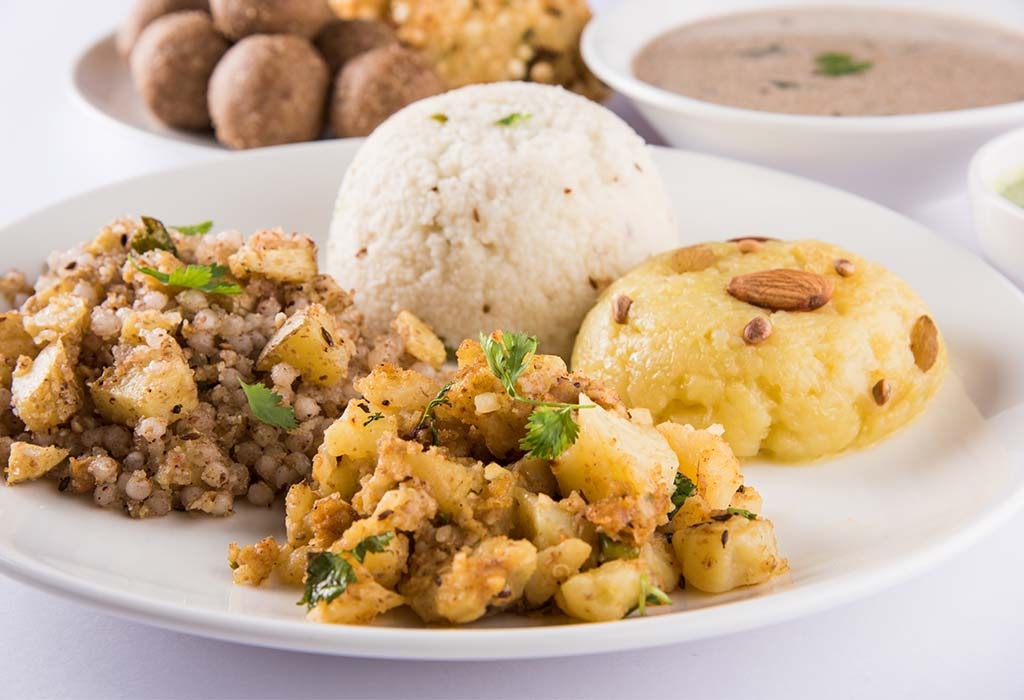What’s Navratri fasting but a ritualized version of the once-a-day-meal plan associated with intermittent fasting? It allows you to repair and reset your body, sleep and rest. Of course, it has enough checks and balances to ensure that your hunger pangs do not kick in and that you can detoxify your body over a period of nine days without giving into indulgence. Evidence suggests that this results in fat reduction and some weight loss as you become self-disciplined and correct your food choices.
THE SCIENCE OF THE THALI
The science of the Navratri meal plan is pretty simple. It is low carbohydrate, rich in fibres and plant protein, and includes fruits, vegetables and nuts rich in micronutrients. It hydrates your system with a heavy reliance on liquids. The first energy burst comes from fruits, which take time to be digested. So, by the time you get to your once-a-day-thali, which is again a balanced meal, you cannot overeat. And since you are not allowed to sleep for two hours after your big thali (ritualized as your meditative hours), the food doesn’t sit heavy on your stomach. Instead, it calms your brain and helps you slip into deep sleep, healing your body in the process.

The platter is heavy on legumes in the north, tapioca and tamarind in the south, which help in energy distribution. Millets and roots feature abundantly as does sabudana or sago, a complex carbohydrate or resistant starch, which gives energy, regulates blood pressure and improves the nervous system. Instead of chutneys and pickles, the yogurt slurry with neem flowers, raw mango, jaggery, pepper powder and coconut shavings increases your saliva and helps you masticate your food better. This prevents cravings.
MILLETS TO THE RESCUE
The best is Samak rice, also known as barnyard millet. These creamish tiny seeds are high in resistant starch, which slows down sugar release in the bloodstream and is packed with fibre, protein and micronutrients like zinc and iron. “Samak is gluten-free, high in fibres and protein as well as low in calories, which means it can help you lose weight if eaten over a sustained period of time,” says holistic health expert Dr Mickey Mehta. It further suppresses body inflammation, improves gut health and reduces LDL or bad cholesterol in the body. “Iron is key to regulating body temperature and maintaining respiratory health during a change of seasons. Samak rice is low in phytic acid, so enables greater absorption of key minerals like calcium and magnesium,” he adds.
The gluten-free rajgira (amaranth) has more than 10 per cent protein while kuttu (buckwheat millet) provides a good dose of calcium, iron, vitamin B6 and magnesium. These millets are rich in micronutrients, have a medium glycemic index (GI) of about 45. “Cook them with vegetables like spinach, bottle gourd, carrots and other seasonal vegetables to reduce the overall load. In fact, insulin and glucose receptors in the body get activated by the rich magnesium content in millets,” says Dr Mehta.
Sendha namak or rock salt helps take care of our sodium and potassium levels and rids the body of water retention. “It controls your blood pressure and helps you absorb minerals better than common salt. Buttermilk is rich in probiotics and good for gut health,” explains Dr Mehta.
WHICH VEGETABLES, FRUITS WORK?
Choose water-based fruits and vegetables like gourds and pumpkin, which sit easy on the stomach. Says Vani Krishna, Chief Nutritionist, Manipal Hospital, Bengaluru, “Potatoes and sweet potatoes are commonly consumed for energy. But since these have high carbohydrates, include them as part of your daily recommended calorie allowance and do not factor them in as vegetables. People with diabetes can have fruits as per their usual guidelines, providing a maximum of 30 gram carbohydrates per day, to be had in two portions.”
Sendha namak or rock salt helps take care of our sodium and potassium levels and rids the body of water retention. “It controls your blood pressure and helps you absorb minerals better than common salt. Buttermilk is rich in probiotics and good for gut health,” explains Dr Mehta.
WHICH VEGETABLES, FRUITS WORK?
Choose water-based fruits and vegetables like gourds and pumpkin, which sit easy on the stomach. Says Vani Krishna, Chief Nutritionist, Manipal Hospital, Bengaluru, “Potatoes and sweet potatoes are commonly consumed for energy. But since these have high carbohydrates, include them as part of your daily recommended calorie allowance and do not factor them in as vegetables. People with diabetes can have fruits as per their usual guidelines, providing a maximum of 30 gram carbohydrates per day, to be had in two portions.”
Visit us – http://www.aarogyapath.in
